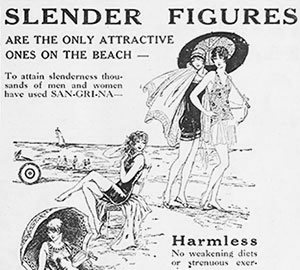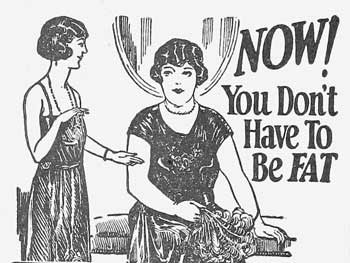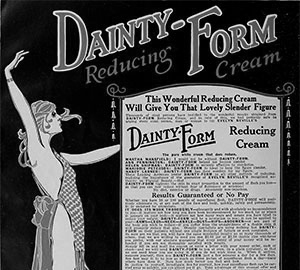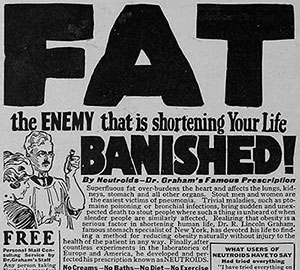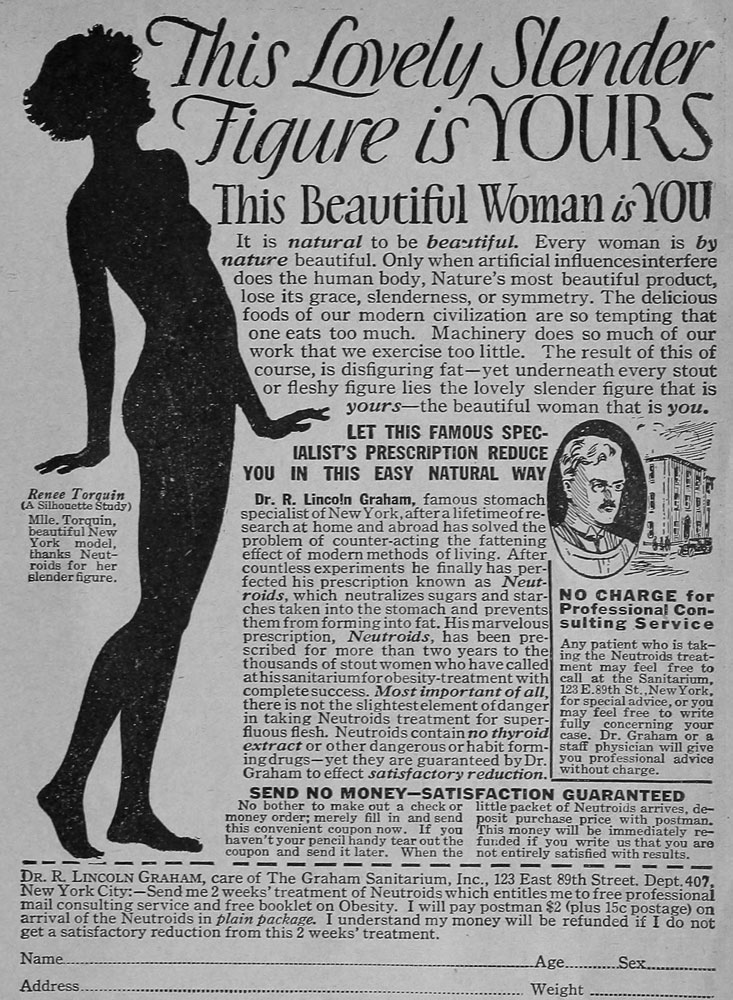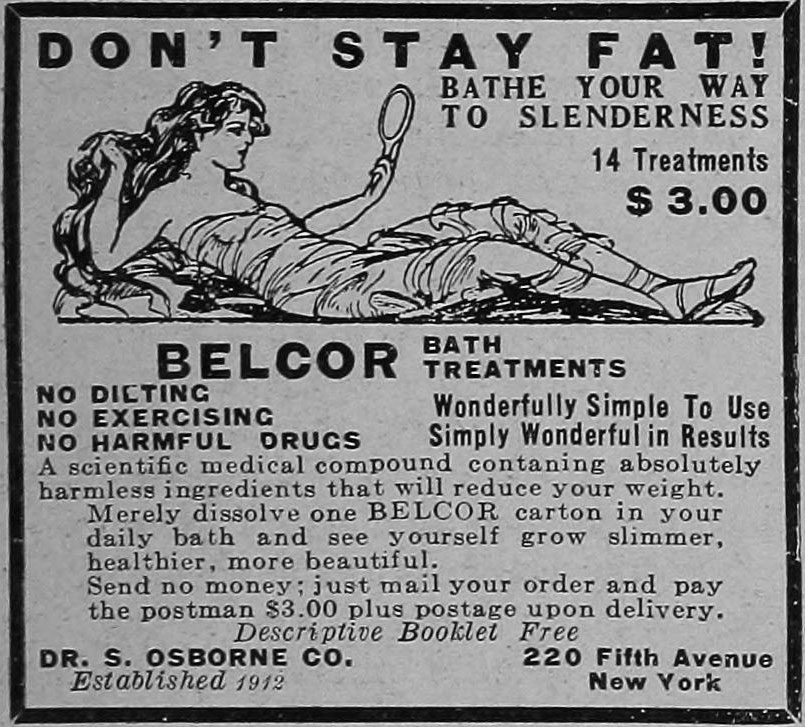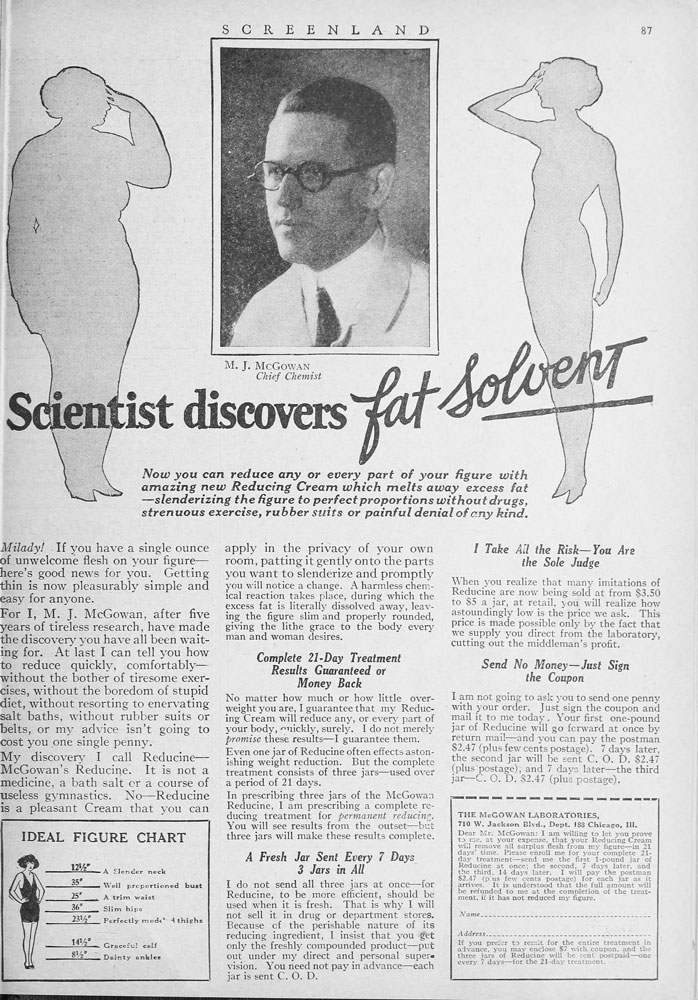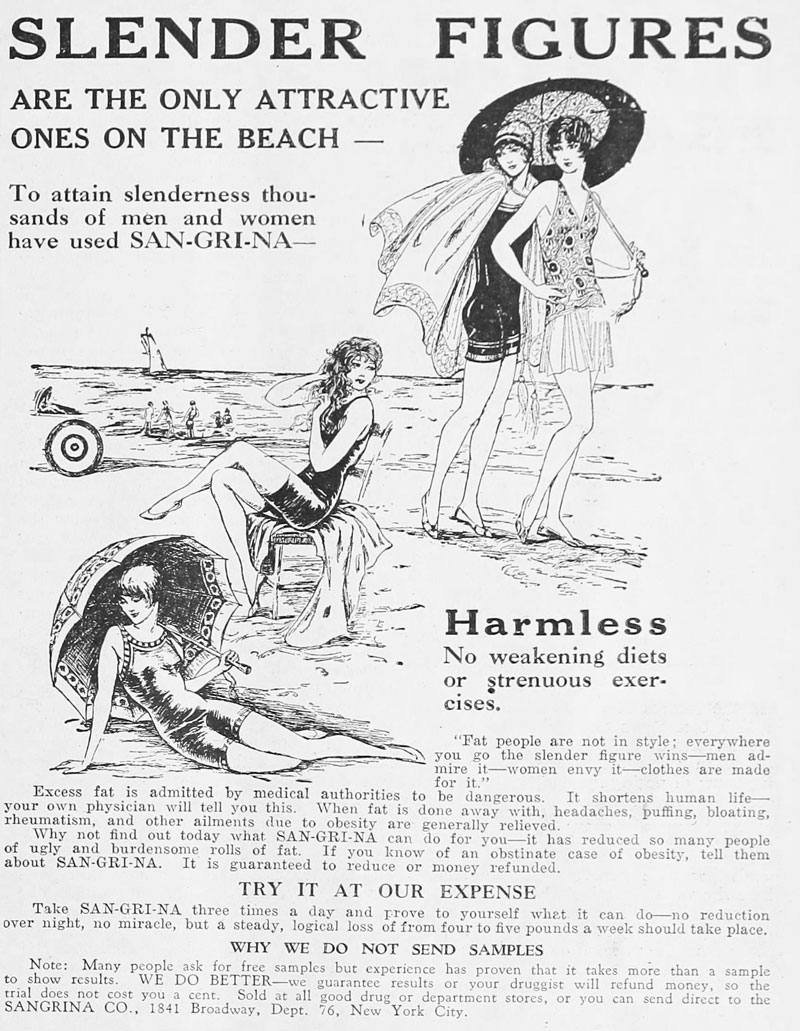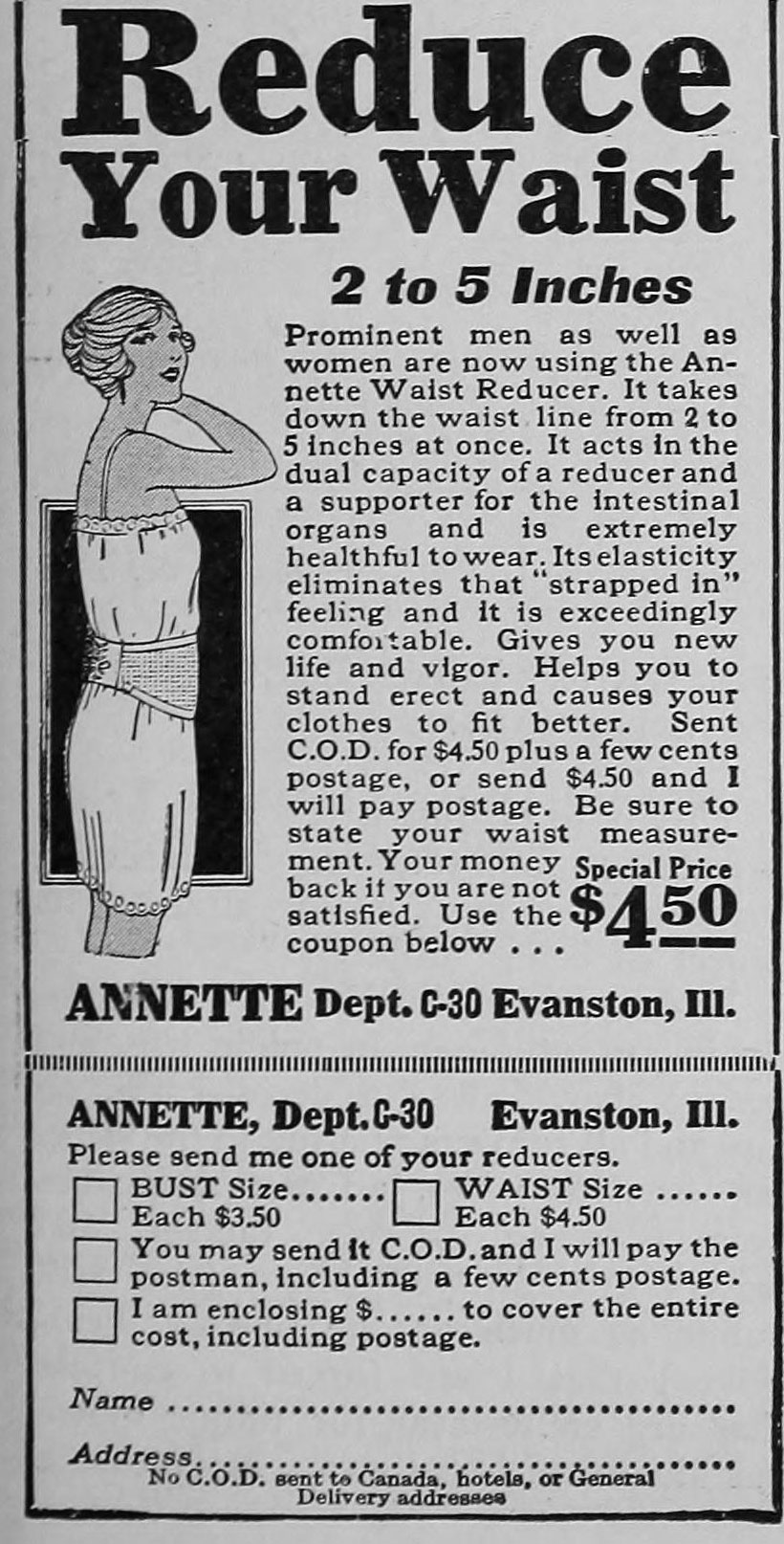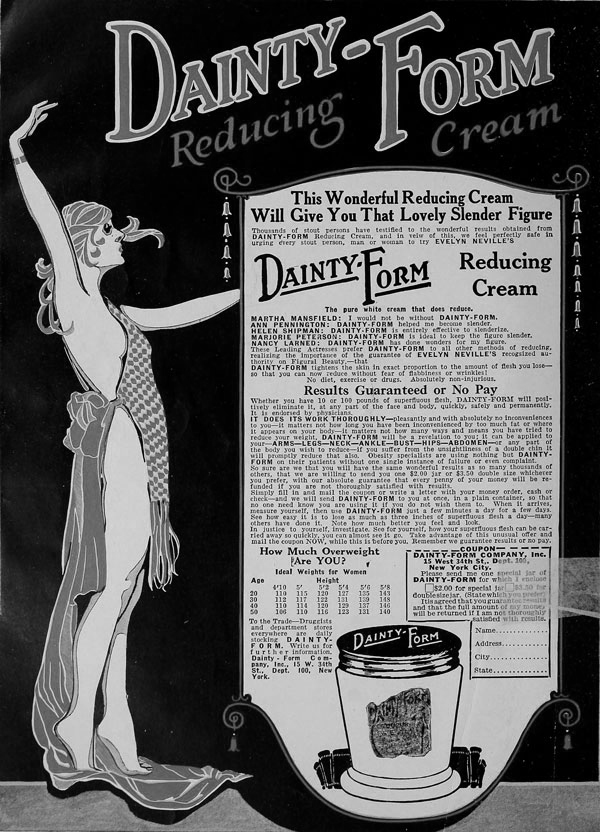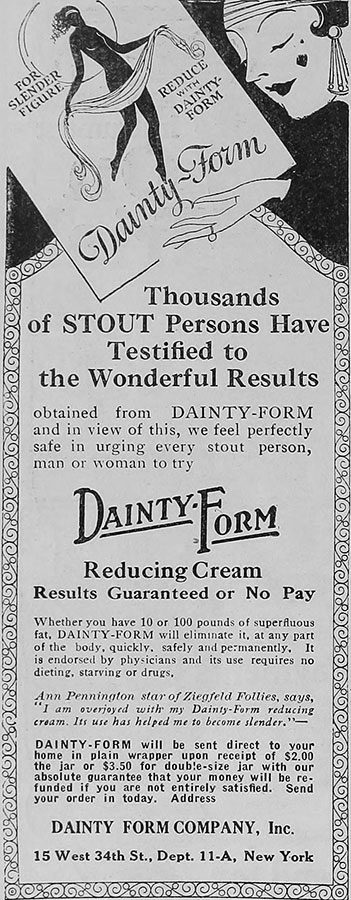The Craze & the Proliferation of Quackery

Reducing Gum. 1927.
Click to enlarge.
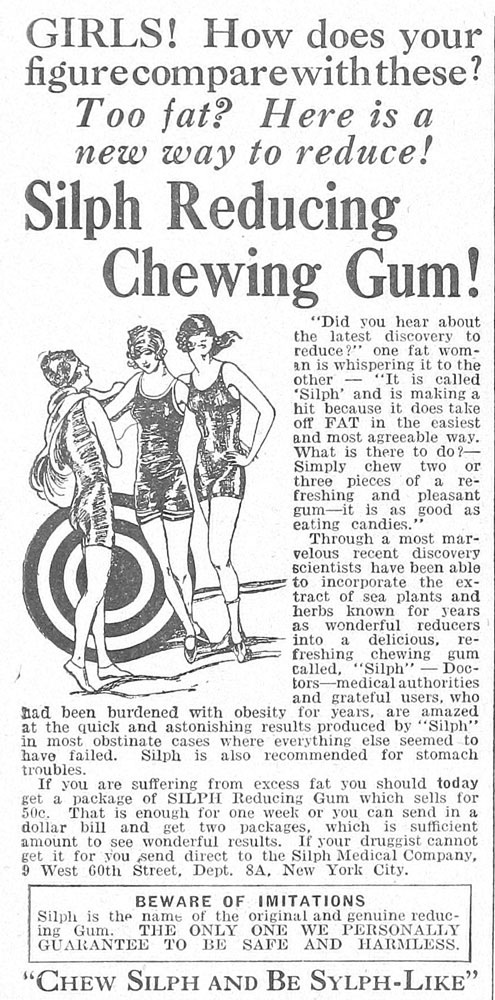
Although the roots of the reducing craze go back further than 1920, the craze reachs its height in the 1920s. The craze involved new methods of reducing by artificial means, most of which were heavily advertised in popular magazines of the period. In 1925, a journalist reported, “Reducing has become a national pastime . . . a craze, a national fanaticism, a frenzy.”[1] Hillel Schwartz claims that the “Roaring Twenties were also the calculating, calorie controlled, ounce-conscious Grim twenties.”[2] The craze took place mainly among white, middle-class American women who were urged by advertisers to shed fat in order to be happier, more attractive to men, and more successful. Advertisements in magazines, particularly Hollywood fan magazines, were one of the main platforms through which ideas about women’s bodies were disseminated.[3] While movies also played a role, advertisements directly guided women in their attempts to reduce. The advertisements and their attitude toward women and fat were very much reflective of the dominant cultural attitude of the 1920s. These advertisements were also what would lead to a change in the dominant reducing discussion.
The advertisements found in these magazines represented a transition. As Heather Addison shows, advertisements before the craze tended to be informational in nature and offered healthy eating or exercise tips rather than aiming to shame and humiliate readers into reducing.[4] By 1920, advertisements used emotional appeal to convince readers that they needed to lose weight in order to live happier lives, as well as to achieve beauty. Reducing products that were advertised ranged from harmless special stockings to dangerous pills that contained thyroid hormones or other drugs. Fat was berated as a disgusting menace to a society focused on productivity in the new industrial age.[5]
Consumerism and modern advertising emerged together in the early twentieth century. The culture of consumption developed between 1880 and 1920 and created a new pressure to buy. The new focus on consumption can be seen in the advertisements found in popular magazines during this period. Consumerism in America was the result of both economic and noneconomic institutions working together to create what historian William Leach described as “the democratization of desire and the cult of the new.”[6] By the 1920s advertising was used to create a dissatisfaction and self-consciousness that sought to convince readers to continually buy the products advertised in magazines. This proved exceptionally effective in the case of dieting and women’s bodies.
The reducing craze played out mainly in the advertising sections of popular Hollywood fan magazines. The reducing advertisements and claims in these publications very rarely specifically mentioned the Hollywood stars. However, by placing them in fan magazines where the stars’ lives and appearances were discussed, the association was implied. The Hollywood star system emerged around 1912-1913 and the “picture personality” became the dominant focus of motion pictures. Addison argues that stars of the period functioned in four key ways: as the “truth of films,” as ideal figures, as living proof that the fantasy lifestyles of on-screen characters could exist in the real world, and as examples of success for those who wanted to become stars themselves.[7]
Reducing was considered one of the professional duties of motion picture stars, thus making all stars de facto experts in the physical culture arena
Fan magazines became the primary arena in which stars, their lives, and their careers were discussed. Addison asserts that “as article after article clearly documents, reducing was considered one of the professional duties of motion picture stars, thus making all stars de facto experts in the physical culture arena.”[8] As the star system developed and big stars such as Clara Bow continued to appear both on screen and in fan magazines, stars began to have an influence on physical culture. Fans sought to model themselves after the stars and that model included the physical culture routines and diets of movie celebrities.[9] As Addison clearly points out, the stars of the 1920s and their attempts to “drug, diet, pound, and roll themselves into shape” must have encouraged at least some women who admired and looked up to the stars to do the same.[10] Fan magazines and the stars who were featured within them had, at the very least, some impact on the proliferation and the popularity of the reducing craze in the 1920s.

Click to enlarge.

The advertisements in women’s magazines invited women to look at, dream about, and decide on purchases based on fan magazine fantasies about slim starlets and their glamorous lifestyles.[11] Reducing products consisted of pills, crèmes, equipment, soaps, and pamphlets. The advertisements urged readers to remove fat and reduce through the effortless, but often dangerous, use of their products. These advertisements reveal the common themes and ideas about the body and reducing that the advertisers wanted women to believe in. Tablets and pills were one of the most common types of advertisements, but also some of the most dangerous. The pills supposedly contained ingredients that helped to “neutralize fattening agents” in the body and advertisers often claimed they were endorsed and supported by doctors.[12] However, these pills often contained thyroid hormones and other dangerous substances. The companies sought to invoke a sense of authority and trust by claiming that the effectiveness of their products was based on scientific evidence and endorsed by doctors. These advertisements underscored the need for women to “seek their natural beauty, which becomes hidden when artificial influences cause the grace, slenderness and symmetry of the natural body to be lost.”[13] In line with the new idea of the streamlined body, these advertisements emphasized the need for women to reduce in order to uncover their slender and beautiful figures. As a result, these advertisements inherently implied that anything other than a slender, graceful, and symmetrical body was unattractive and shameful.
The delicious foods of our modern civilization are so tempting that one eats too much. Machinery does so much of our work that we exercise too little. The result of this of course, is disfiguring fat."
Furthermore, in these advertisements mechanization is blamed for the increase of fat in society. An advertisement for Dr. R. Lincoln Graham’s netroid pills that appeared in Photoplay asserts that, “the delicious foods of our modern civilization are so tempting that one eats too much. Machinery does so much of our work that we exercise too little. The result of this of course, is disfiguring fat….[14] Blaming larger societal forces for the increase in weight removed personal responsibility from the fan magazine reader. The advertisements argued that the answer was simple. Reducing could be easy and effortless, if their product was used.

Reducing crèmes and soaps were another common type of product found in magazines. Advertisers of these products sought to appeal to those consumers who might have been hesitant about using pills to reduce. They often drew on the exoticism of European techniques and stressed the effortless nature of reducing with such a product. An advertisement for a bath soap explained to readers:
A European discovery makes it possible to reduce weight as nature herself reduces. Florazona actually washes away excess flesh through the pores. Don’t risk your health with starvation diets, heart-straining exercises, internal drugs. Simply empty a package of fragrant Florazona in your bath.[7]
The focus on what were claimed to be European techniques and discoveries was featured prominently in many advertisements of the period. These advertisements sought to establish credibility by linking their product to Europe.
Another advertisement claimed “Reduce…No Diet; no drugs; no exercise. Dainty Form melts away your fat as if by magic just where you want to lose it.”[16] The ease and effortlessness of reducing was a consistent and fundamental ingredient in these advertisements. Products promised not only to reduce fat without diet or exercise, but also claimed that radical results could be achieved overnight. Dainty Form reducing cream promised readers that it was possible to lose six pounds in one day.[17]
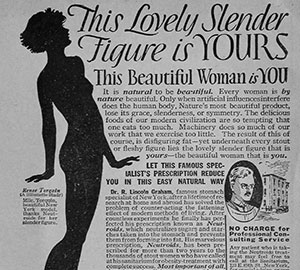
Dr. R. Lincoln Graham's Neutroids.
Screenland October 1923.
Click to enlarge.
Belcor Bath Treatments Screenland October 1923 
McGowan's Reducine Screenland May 1926
